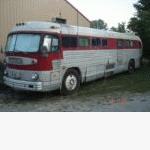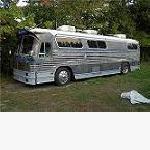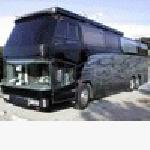| Author | Message | ||
| doug yes (Dougg)
Registered Member Username: Dougg Post Number: 134 Registered: 1-2007 Posted From: 174.131.120.134 Rating: N/A |
Some engineering speculation: The reason an ac generator is not easily hooked to your bus engine is lack of a steady rpm to provide steady current. Is that correct? Could a Continuously Variable Transmission be mounted on the gen head shaft to control the rpm? | ||
| Dal Farnworth (Dallas)
Registered Member Username: Dallas Post Number: 335 Registered: 7-2004 Posted From: 72.172.39.50  Rating: N/A |
It possibly could, if it could change speeds quikly enough, but I think it might be cost prohibitve to do so. DC generation with an inverter would probably be cheaper and more reliable. However, this is just my opinion and has no basis in fact. | ||
| Jim Wallin (Powderseeker01)
Registered Member Username: Powderseeker01 Post Number: 108 Registered: 10-2008 Posted From: 70.90.115.49  Rating: N/A |
It is the frequency, not the current that is affected by generator speed unless you have multiple units in parallel, then the "frequency" is adjusted to balance the load across units. If you want to run a generator head from your bus engine, be sure to get one that will produce 60 hertz at 1800 rpm, many of the smaller units are wound to operate at 3600 rpm, which would probably not be too good for your bus engine. | ||
| FAST FRED (Fast_fred)
Registered Member Username: Fast_fred Post Number: 1439 Registered: 10-2006 Posted From: 66.82.9.83  Rating: N/A |
The reason an ac generator is not easily hooked to your bus engine is lack of a steady rpm to provide steady current. Is that correct? This was true in decades past. Today the source is chopped into tiny pieces and re assembled for 50 or 60 CPS as desired. The tech is so cheap that small gas AC gen sets use the setup to allow variable RPM and load the engine better at low loads with low RPM . Mastervolt is a marine leader , but you wont like Yacht pricing . Of course if your "40" is 40 METERS , price wont be a problem. FF | ||
| Jim Sanders (Sandy)
Registered Member Username: Sandy Post Number: 17 Registered: 1-2011 Posted From: 69.199.96.250  Rating: N/A |
Hey Guys you are discussing a subject dear to my own heart. Since my back ground is strictly machine shop (50 years)vrs. 3 semesters in collage of basic elect. I know enough to be dangers to any one around me. I understand that many ac generators can be ran with all 60cps??? But how this can be done????????? | ||
| Jim Sanders (Sandy)
Registered Member Username: Sandy Post Number: 18 Registered: 1-2011 Posted From: 69.199.96.250  Rating: N/A |
I have read about and saw AC elect being produce with a gen running off a main enj. Useing spring loaded pully set up. Hoo effective this is i dont know??? I see all kinds of problems?? | ||
| Sean Welsh (Sean)
Registered Member Username: Sean Post Number: 1234 Registered: 1-2003 Posted From: 72.171.0.141  Rating: |
The short answer is "no." The reason is that a CVT's output speed is not a direct function of input speed, but rather a function of both speed and load. If the generator head presented a fixed load, you might be able to adjust a CVT such that the output speed would be 1800 (or 3600) RPM at all input speeds. However, the load the generator head presents to the shaft depends on the electrical load on the generator, which will be variable. As Jim wrote, the head speed determines the generator's frequency, not current. Incidentally, there is a generator made explicitly to be connected via belt to your main engine. However, it comes with an electronic throttle control that adjusts engine speed to produce 60Hz output, and can only be used when the vehicle is parked. It is called an AuraGen. I agree with Dallas and Fred, easier and cheaper to do this with a high-output DC alternator and an inverter.
Only in a very small handful of sets. The vast majority of generators made today are still synchronous 1800 or 3600 rpm units (for 60Hz, or 1500 or 3000 rpm units for 50Hz). That would include almost all RV generators, most home backup generators, and even most portable or contractor generators other than the 1-2kW models. That said, the technology is available to do this for much larger installations. I once had an entire datacenter that was backed up by a 100kW or so DC generator. Of course, that ran at 400 volts -- you will not find 400-volt inverters in bus-friendly sizing.
Sorry, I don't understand the question. Synchronous AC generators made for use in the US all have 60Hz (cycles per second) output, which is why they must be spun at 1800 RPM for a four-pole unit, or 3600 RPM for a two-pole model. (Yes, there are also six-pole units that run at 1200 RPM and eight-pole units at 800 RPM, and even 12-pole models at 600 RPM.) Most US-spec heads can be run at 5/6 speed to produce 50Hz power if that's what is needed, however this usually also reduces the head's power rating to 5/6 of nameplate. The reverse is not necessarily true: heads built to European specs and meant to be run at 1500 or 3000 RPM are not always built to be run faster for the US market -- check the manufacturer's data sheet to be sure. -Sean http://OurOdyssey.BlogSpot.com | ||
| Tom Christman (Tchristman)
Registered Member Username: Tchristman Post Number: 282 Registered: 1-2006 Posted From: 66.218.33.156 Rating: N/A |
At one point-there was a variable speed belt driven generator that was available for marine use-but that's because a boat engine generally runs at a near continuous rpm (if the seas are flat). Now with the pure sine wave inverters, just use either the 50DN alternator, or two "smaller" truck type alternators and invert the DC power to AC. Good Luck, TomC | ||
| Jim Sanders (Sandy)
Registered Member Username: Sandy Post Number: 19 Registered: 1-2011 Posted From: 69.199.96.250  Rating: N/A |
Sean i have never believed or ran inverters!!!Am i full s--- ??? I have owned a number of boats. 40ft up Battery chargers has Allwase gave me a pain in the rear!!! Pay 3k or up!! Still the same story. Burnt bat. The cheapest method Hire A Skipper. Problem solved. Difference between Boat or RV????? | ||
| Dal Farnworth (Dallas)
Registered Member Username: Dallas Post Number: 338 Registered: 7-2004 Posted From: 72.172.39.50  Rating: N/A |
Jim, inverters, even some of the lower end versions work quite well. We run our fridge on a 1750 watt inverter, MSW, and before our last inverter broke, (3000W, Sima, MSW), ran it on that for a total of 6 years. We also run the fluorescent lights, home computers, Monitors, TV set and just about everything but the A/C from it. We've never had a problem and I've really put them through hell. The problem with the really low end inverters is that the 'steps' of the sinewave are broken up so much that electronics and some compressor motors have problems. What you really have to remember is that "Pure Sine Wave" inverters are nothing more than "MSW" (Modified Sine Wave), with more steps that more closely emulate a true sinewave from the power company or your generator. Modern generators now are moving to more and more inverter power, meaning the genset engine runs an alternator which is then converted back to AC through an inverter. One interesting point, car, truck, aircraft and probably the Russian space program that use alternators are actually creating "AC" which is then changed to "DC" through the diode trio inside the alternator. Inherently inefficient, it's still the best game in town. But..... I still have the original dual field generator on my 6-71.. two fields that can deliver 160 amps each for a total of 320 amps at anything above about 1200 rpm. I can rebuild it on the side of the road, it's not oil cooled, and when I had the 3000W inverter running had no problem keeping up with a 15KBtu roof air and the other systems on board. Something to be said about old technology there I think. | ||
| Jim Sanders (Sandy)
Registered Member Username: Sandy Post Number: 20 Registered: 1-2011 Posted From: 69.199.96.250  Rating: N/A |
Dal I am looking forward to meeting with you. Will try to make it this week. I have no idea of what i am going to install in the FLX. Ideas app. Jim | ||
| Dal Farnworth (Dallas)
Registered Member Username: Dallas Post Number: 341 Registered: 7-2004 Posted From: 72.172.39.50  Rating: N/A |
We'll be looking forward to it! Rest your thoughts, install a acc. pulley and run a truck Alternator.... Leece Neville, Delco, Bosch... You have no OTR A/C so don't need the high amp Delco 50DN of bygone days. (Unlike the guy with the cheap Tuxedo and the 4106 that hasn't moved in years). | ||
| Jack Fids (Jack_fids)
Registered Member Username: Jack_fids Post Number: 414 Registered: 1-2009 Posted From: 72.211.128.245  Rating: N/A |
GRRRRRR . .  Hey Ace, this one ain't on topic either! | ||
| Len Silva (Lsilva)
Registered Member Username: Lsilva Post Number: 436 Registered: 12-2000 Posted From: 72.187.35.208  Rating: N/A |
As noted, I don't think you could get a CVT to respond fast enough to maintain the proper frequency. I think it MAY be possible, albeit complicated and expensive, to do it with hydraulics, including a large accumulator tank and some very sophisticated speed controls. Given the lower costs of the new and improved inverters, I just don't think it's practical to even try. |